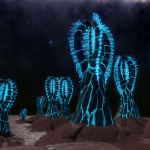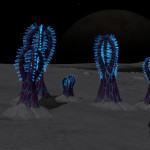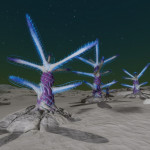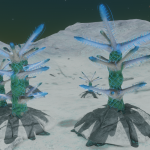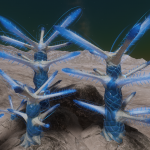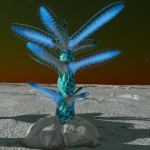Electricae genus
Description
Organisms found exclusively on extremely cold ice worlds in the vicinity of frozen lakes. The visible tips can be observed protruding from the ice, often near fissures where it is thinnest. The bulk of the organisms extend down through the ice into subsurface melt potentially for several kilometres. Electricae are superconductive in nature. utilising the thermal circulation of the surrounding fluid to drive an electrochemical process. This is probably why they are limited to planets with atmospheres dominated by noble gases. The surface structure exists to provide a connection to the atmosphere, which in turn creates a point of electrical potential difference. A by-product of this is the bioluminescent display that runs through the organism. Although never witnessed, reproduction presumably occurs below the surface by some unidentified process.
Minimum distance between two genetic samples: 1 000 m
Conditions of occurrence
- Planet with thin Helium, Neon or Argon atmosphere
- Icy planets
- Maximum gravity: 0.27
Electricae pluma

Description
A species of electricae that extends a tip of four connected loops above the ice, each covered with brightly luminous fronds. This species is typically found on planets orbiting bright white stars.
Conditions of occurrence
- Planet with thin Helium, Neon or Argon atmosphere
- Icy planets
- Parent star of type A, with a luminosity class of V or more or Neutron star. To be confirmed: type O, B, White dwarf, black hole.
- Maximum gravity: 0.27
Colored variants
Colored variant determined by rare material found on planet:
| Material | Color |
|---|---|
| Antinomy | Cobalt |
| Polonium | Cyan |
| Ruthenium | Blue |
| Technetium | Magenta |
| Tellurium | Red |
| Yttrium | Mulberry |
Electricae radialem

Description
These electricae species protrude bioluminescent stalks that radiate out in all directions. It is thought that this species may have an unspecified link with the proximity of nebulae to its host planet.
Conditions of occurrence
- Planet with thin Helium, Neon or Argon atmosphere
- Icy planets
- Near de Nebulae
- Maximum gravity: 0.27
Colored variants
Colored variant determined by rare material found on planet:
| Material | Color |
|---|---|
| Antinomy | Cyan |
| Polonium | Cobalt |
| Ruthenium | Blue |
| Technetium | Aquamarine |
| Tellurium | Magenta |
| Yttrium | Green |
